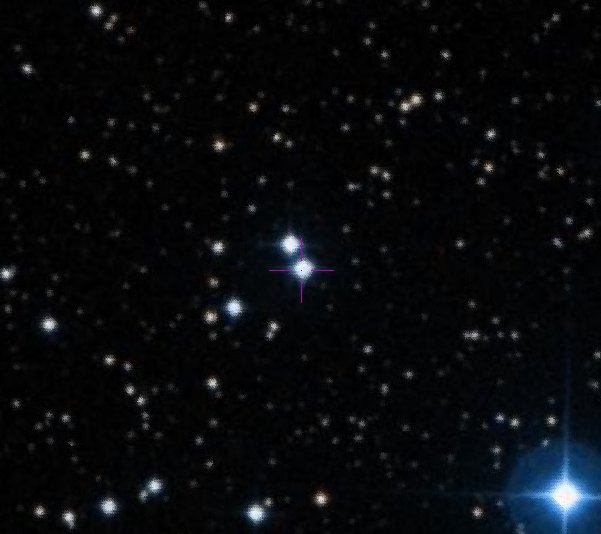Little Tycho Observatory
703 McNeill Road, Silver Spring, Md 20910
rkk_529@hotmail.com
Abstract: A new double star has been found in Cepheus, at 21:55:22.8 +65:01:40.8, J2000. A measurement made with the Aladin tool1 of the new double gives 15.6 arc seconds of separation and a position angle of 27°. The APASS2 visual magnitudes, as reported by the UCAC43 are 11.1 and 11.35. Historical data from the stars are listed, as are distance estimates to the pair.
The pair was found while observing STT 457, WDS ID: 21555+6519. Again using the Aladin tool, the UCAC4 listed the proper motions (in milliarcseconds per year) of the pair as:
Primary pmRA: -0.5, pmDec: -5.8.
Secondary pmRa: -0.8, pmDec: -8.2.
This was reported to William Hartkopf4 of the USNO5, who has included it in the WDS6 as TVB 7.
The primary's UCAC4 id is 569-000097,
and the secondary's UCAC4 id is 569-000094.
Dr. Hartkopf researched the new pair and emailed me his results:
"I extracted Tycho7, UCAC4, and 2MASS9 measures, as well as two photographic measures from 1895 and 1903 - so 5 astrometry measures spanning over a century, plus 5 additional photometry measures."
These results are shown in the table below:
| Date | Rho | Error in Rho | Theta | Error in theta | A mag | Error in A mag | B mag | Error in B mag | FEW | FWHM | Aperture | Obs ct | Source | Type |
| 1895.88 | 23.9 | 15.857 |
| B | 0.3 | 1 | WFC1998 | Pa | ||||||
| 1903.73 | 26.7 | 15.780 |
| B | 0.3 | 1 | WFC1998 | Pa | ||||||
| 1991.66 | 26.8 | | 15.908 | | 11.096 | 0.077 | 11.353 | 0.093 | 530 | 100 | 1.4 | 1 | TYC2000b | Ht |
| 1991.66 | | | | 11.526 | 0.072 | 12.130 | 0.136 | 430 | 90 | 1.4 | 1 | TYC2000b | Ht | |
| 1999.74 | 27.1 | | 15.71 | 10.062 | 0.026 | 10.413 | 0.026 | 1256 | 245 | 1.3 | 1 | TMA2003 | E2 | |
| 1999.74 | | | 9.822 | 0.030 | 0.174 | 0.028 | 1633 | 160 | 1.3 | 1 | TMA2003 | E2 | ||
| 1999.74 | | | 9.795 | 0.021 | 0.157 | 0.019 | 2210 | 300 | 1.3 | 1 | TMA2003 | E2 | ||
| 2003.702 | 27.0 | 0.1 | 15.746 | 0.029 | 10.95 | 0.03 | 11.33 | 0.05 | 609 | 70 | 0.2 | 4 | UC_2013a | Eu |
Based on the Wikipedia H-R diagram9, and UCAC4 blue and visual magnitudes, the primary appears to have a spectral class of A8, and the secondary F9. Assuming these stars to be main sequence dwarves, this gives them approximate absolute magnitudes of +4 and +6. Using the well known distance modulus equation:
M - m = 5(log10(d)) - 5, where M is the absolute magnitude, m the apparent magnitude, and d is the distance in parsecs,solving for d gives:
d = 10((m - M + 5) / 5).
Distances of 250 and 120 parsecs result from the absolute magnitudes of +4 and +6, respectively. If they are both sub giants, however, the absolute magnitudes are both close to +3, giving a distance of about 400 parsecs.
Below is a photo of the new binary from the DSS as rendered by the Aladin Sky Atlas tool.

Note that the proper motions associated with these stars are fairly small, although rho and theta have shown little change from when the pair was first measured. It is hoped that observations from the recent Gaia mission, and other subsequent measurements will establish that this pair, and many like it, are physical.
The author wishes to acknowledge the editorial assistance of William Hartkopf, Tom Corbin, and Kathleen Bryant in making this short paper more readable.
3) The Fourth US Naval Observatory CCD Astrograph Catalog (UCAC4) Zacharias, et al, 2012.
4) William Hartkopf, Astrometry Department, U.S. Naval Observatory 3450 Massachusetts Ave, NW, Washington, DC 20392